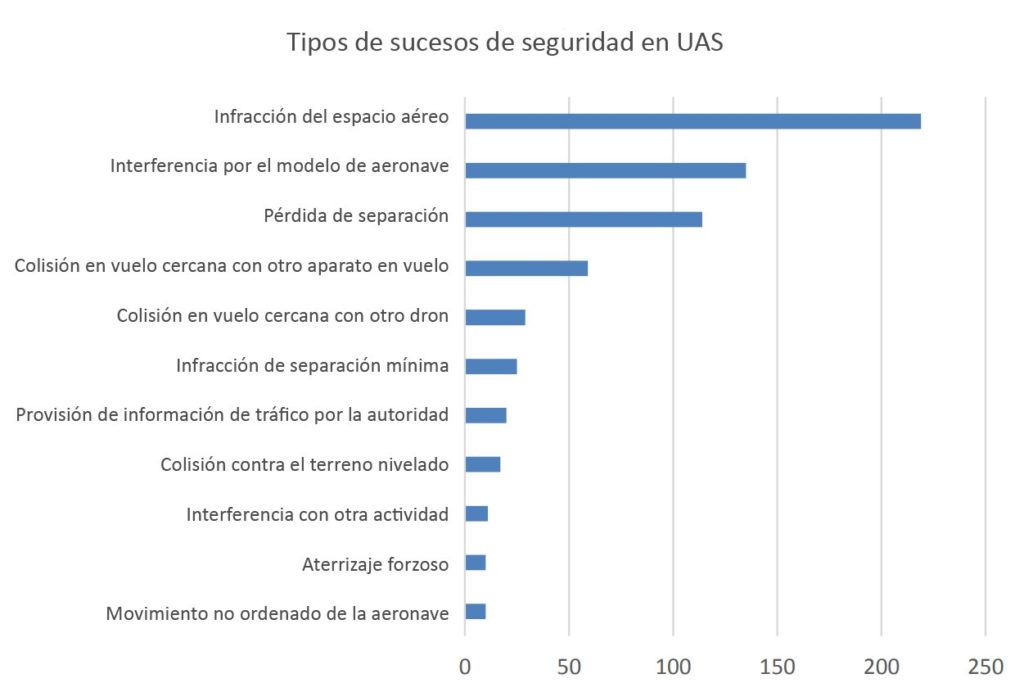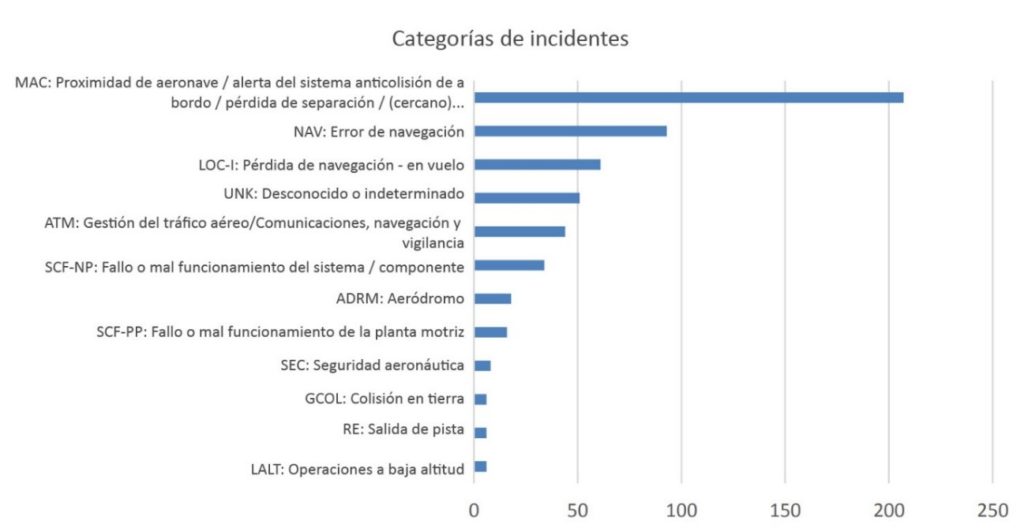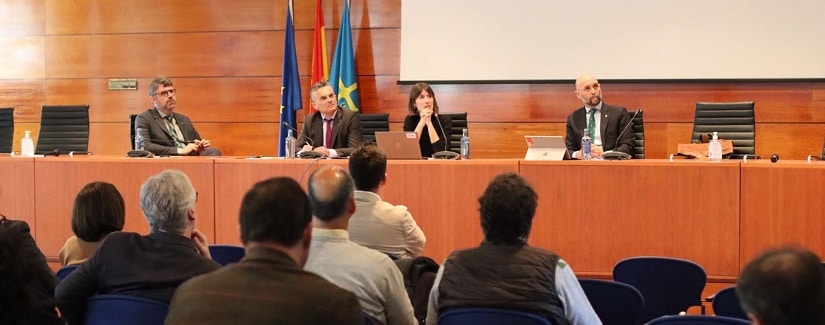Industrial progress and technological applications have brought about and developed Unmanned Aerial Systems (UAS). Their implementation in various tasks leads to improvements in operating processes and increases business productivity, but it is not without its risks. Mitigating these risks requires an international regulatory framework to be established that would incentivize their use, which is seen as one of the main challenges for an expanding market.
The primary risks of an unmanned aerial system operation can be classed into three types, according to Antidio Viguria, technical director of Avionics and Systems at the Advanced Center for Aerospace Technology (CATEC):
–Risk of in-air collision. The hazard posed by a collision between a manned aircraft and a UAS in operation is significant, as manned aircraft are not designed to withstand an impact of this magnitude, which could lead to a catastrophic accident.
– Land risk. This considers the possibility of the unmanned system experiencing a technical problem and beginning an uncontrolled descent, harming anyone found below the area where the device is operating. Of course, this risk depends on the aircraft’s size and weight, and the damage depends on the population density in the area of operation.
– Specific risk to critical infrastructure. This risk takes into account the possible impact caused by an accident or an uncontrolled descent of the aircraft, but not to the people in the surroundings, rather to infrastructure—refineries, power lines, railroads, etc.
The first two risks are fundamental in any aerial operation and are taken into account in the SORA methodology (Specific Operations Risk Assessment), which was adopted by the European Aviation Safety Agency (EASA) for operations in the specific category of the new European regulations that were published in 2019 and become effective on July 1, 2020.
To reduce the threat, operations can be limited to specific areas with less exposure, thereby avoiding incidents. “The training of UAS pilots is also fundamental to mitigating risks, as a trained pilot—especially one trained in how to respond to emergency situations—can prevent a significant number of accidents,” says Antidio Viguria.
In addition, there is a wide array of technological mitigation methods. Geocaging systems ensure that the UAS will always stay in a preestablished operating area. Consequently, even if the pilot makes a mistake, the drone will automatically stop when it reaches its limit, which is essential in urban environments. Geofencing features notify the pilot if their location is prepared for UAS use, which is important for areas near airports. There are also systems that reduce the impact energy in the event of an uncontrolled descent, such as parachutes.
“In the future, UAS will include another type of mitigation system that is even more advanced, like the ability to detect and avoid obstacles and aircraft,” the CATEC head asserted. These types of features are still in the development phase, and it is expected that they will be implemented in professional UAS in the coming years.
Types of safety events for UAS (from 2010 to May 2016, by year)

Source: UAS Safety Risk Portfolio and Analysis, by EASA
Other ways to reduce the risks associated with the use of drones include properly caring for the devices and having them insured. These vehicles require, like any other, maintenance, repairs, and improvements that update their features, in addition to insurance products that prevent risks and mitigate possible damages from their use. The European Drones Outlook Study: Unlocking the Value for Europe, drafted by the community organization Sesar Joint Undertaking, estimates that the costs associated with insuring and maintaining drones will be around €1.5 billion and €2.3 billion in 2035 and 2050, respectively. Their use will also create between 100,000 and 150,000 jobs.
Integration into airspace
In any event, risks linked to the use of drones are clearly affected by their applications, given that UAS are extremely useful and have drawn interest from a wide variety of sectors. In Europe alone, it is expected that their impact will be greater than €11 billion by 2035. The applications with the greatest potential include:
– Infrastructure inspection: particularly linear structures and structures that require inspection at heights.
– Agriculture: for gathering accurate and recurring information on crop conditions.
– Logistics: for distribution, both in urban environments and poorly connected areas.
– Security: particularly in surveillance.
– Air transportation: transporting people in urban environments and metropolitan areas.
– Construction: collecting data to monitor worksites.
– Energy: inspection and surveillance of electrical power plants, wind farms, gas pipelines, and oil plants.
The most significant obstacle facing massive implementation of drones for industrial use is integrating them into airspace, particularly in the applications that use light drones or small drones (less than a 3-meter wingspan). “Currently, most professional services with drones are done for short-distance operations (less than 500 meters from the pilot), which excessively limits the type of applications and operation efficiency and profitability. Therefore, it is essential to develop technologies and systems that can enable UAS to be used over long distances, integrating them into the airspace,” claims Antidio Viguria, technical director of Avionics and Systems at CATEC.

Once unmanned aerial vehicles can safely operate in airspace, the use of light drones in industry will grow exponentially.
To that end, the European Commission launched the U-Space concept in 2017, which has been developed since then with R&D projects managed by Sesar. “Once drones can safely operate in airspace, the use of light drones in industry will grow exponentially,” says Viguria.
The challenges are greater when addressing applications of air transportation and people transportation, not only in terms of regulatory development and the technologies and systems that enable this type of aircraft to be safely integrated into airspace, but also in improving battery efficiency, reducing noise levels of this type of aircraft, social acceptance of this type of air transportation, etc.
Regulatory progress
In terms of regulations, the situation continues to improve. In 2019, a regulatory framework was established in Europe that would allow for drone services to be implemented for the entire European market, with a common set of rules and removing the market fragmentation that was arising.
However, as the expert asserts, regulations are not being standardized internationally. Although there is an international forum called Jarus, where the regulatory authorities of more than 60 countries meet and share criteria, European regulations are not exactly the same as American regulations and “even less related to what they have in Asian countries, such as China.”
Another important obstacle facing industrial drones is operation in urban environments. Just as in rural areas and poorly connected areas, applications are beginning to be developed primarily to facilitate their use in the logistics sector, “where the potential is enormous as it can significantly facilitate last-mile deliveries.” In cities, “the challenge will no longer be integrating the drones into the airspace, but also preparing the aircraft to comply with all the requirements established by the aeronautical authorities.”
However, progress is already being made in that direction. EASA recently published a proposed amendment that lays out the requirements aircraft must comply with for long-distance flights in urban environments. The problem lies in that developing the aircraft to meet these strict airworthiness requirements can delay implementation in these types of urban-environment applications between 3 and five years, “as currently there is no aircraft on the market that meets them.”
At CATEC, they believe that the drone sector will see significant growth in the coming decade, when technologies and systems are developed that allow them to operate over long distances. “Once this happens, a greater number of applications with drones will begin to be economically viable, which will lead to an increase in the investments that will facilitate exponential growth in the sector,” Antidio Viguria emphasizes.
Incident categories (from 2010 to May 2016, by year)

Source: UAS Safety Risk Portfolio and Analysis, by EASA
This article was written with the participation of…
 Antidio Viguria was division head of Avionics and Systems at the Andalusian Foundation for Aerospace Development – Advanced Center for Aerospace Technology (FADA–CATEC) from 2008 to 2018 and was named technical director of Avionics and Systems in 2019. During this time, he was the main investigator of over 80 projects and research contracts in Spain associated with aerial robotics and unmanned aerial systems.
Antidio Viguria was division head of Avionics and Systems at the Andalusian Foundation for Aerospace Development – Advanced Center for Aerospace Technology (FADA–CATEC) from 2008 to 2018 and was named technical director of Avionics and Systems in 2019. During this time, he was the main investigator of over 80 projects and research contracts in Spain associated with aerial robotics and unmanned aerial systems.He currently manages a team of over 20 (including engineers, researchers, and technicians). He has worked directly in technological development projects with the sector’s main companies, such as Indra, Airbus, GMV, Deimos, and Babcock.
He worked as a technical director in projects with funding from both Spain and the EU through several programs such as Feder-Innterconecta, Innpronta, Innpacto, Collaboration Challenges, CIEN Program, FP7, H2020, Sesar, and Cleansky.
He is also a member of the steering committee at the European robotics association euRobotics and leads the SORA FT in the WG-105 work group at EUROCAE.




